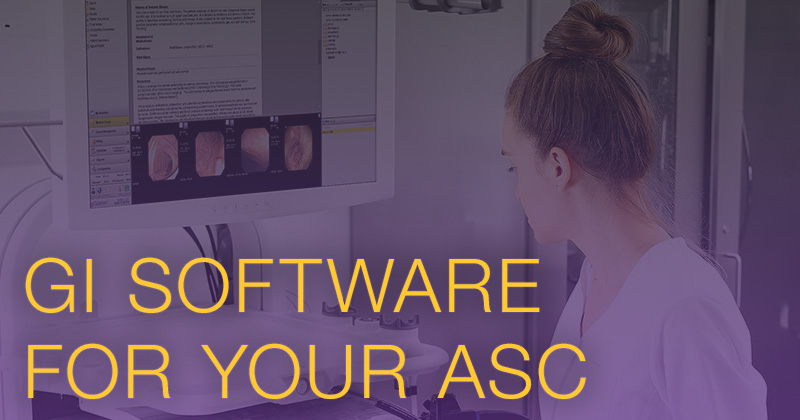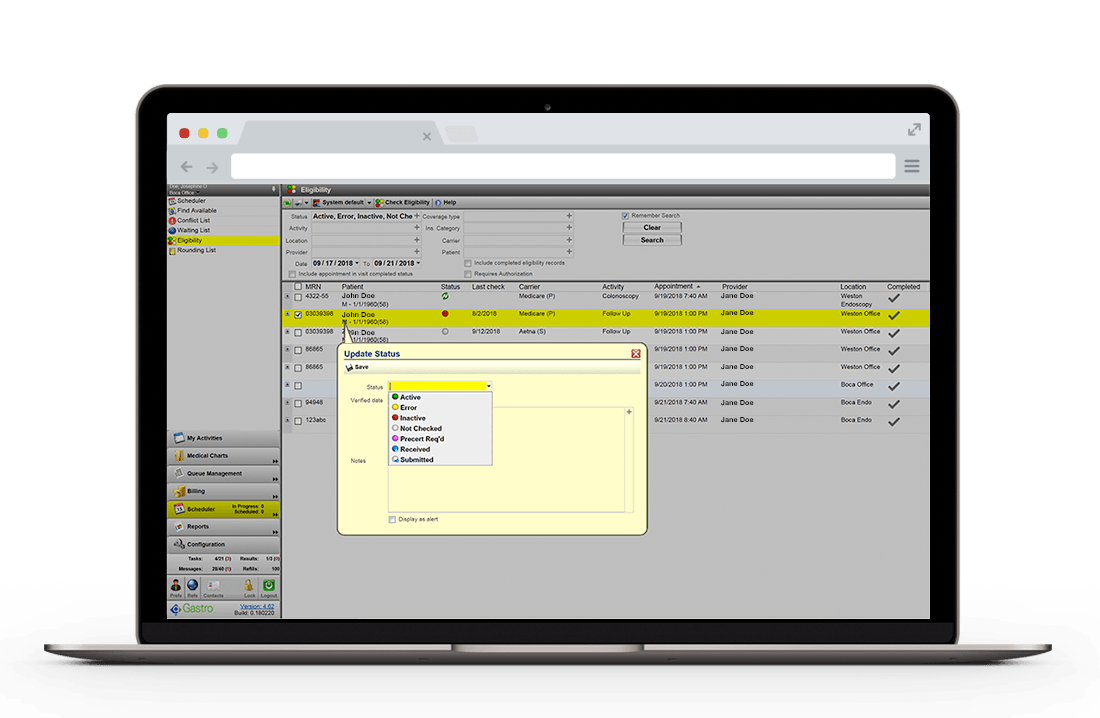Ambulatory Surgery Centers: Integrated GI EHR Solutions and Tools That Can Benefit Your Business Operations

Save time and streamline business operations with ambulatory EHR solutions
In your gastroenterology private practice and hospital, the tools and systems you use on a daily basis can sometimes make or break the efficiency of your operations. When it comes to gastroenterology ambulatory surgery centers (ASCs), it’s no different. As ASC usage rises, and especially if you own a partial stake in your ASC, it’s vital for you to make sure you have the tools you need to succeed. In this post, we’ll look at what tools are available and how to choose what’s right for your practice.
Background: Some ASC History
Go back about 40 years. At that time, nearly all surgeries took place in hospitals. In the U.S., the first ASC came into existence during 1970 in Phoenix, Arizona, to help establish an alternative to inpatient hospital care. It began with two physicians who were fueled by the desire to help eliminate the challenges faced in a hospital setting, such as scheduling delays, limited operating room availability, slow operating room turnover times and budgetary constraints for new equipment. Since then, the use of ASCs for procedures has grown exponentially, and you’ll find gastroenterology procedures at the top of the list in terms of volume.
Today, ASCs are generally viewed as being transformative when it comes to their impact on healthcare as a whole. Out of the top 10 (according to volume) most common outpatient procedures performed in an ASC setting, 4 are gastroenterology procedures.
Based on data from 2018, the number of gastroenterology procedures that were performed annually at ASCs were as follows:
- Egd biopsy single/multiple – 782,955
- Colonoscopy and biopsy – 685, 215
- Colonoscopy with lesion removal – 513, 228
- Diagnostic colonoscopy – 423,124
With such high volume, the people, technology and processes that make an ASC run as a business need to be as streamlined as possible. A well-run ASC can equate to efficient, quality care along with convenience and patient satisfaction.
While there are countless factors to consider when running a successful ASC, I’ll focus on the different types of technology and ASC solutions that make these outpatient centers a focus for the future of medicine, specifically among gastroenterologists.
What is a GI Ambulatory Surgery Center (ASC)?
Let’s start first with defining what a GI ASC is. The American Society for Gastrointestinal Endoscopy (ASGE) describes an ambulatory surgical center as:
The Ambulatory Surgical Center (ASC) is an important part of the practice of gastroenterology, providing a safe, patient friendly and cost effective environment for the provision of medical services, such as colorectal cancer screening colonoscopy, for patients of all ages. The majority of ASCs in which gastroenterologists practice are single specialty centers. Because of their single specialty structure, gastrointestinal ASCs are particularly sensitive to changes in Medicare payments and regulations.
When it comes to GI ASCs, efficiency is key, and increasing patient volume is most likely at the top of the list when it comes to business and operational goals. A crucial component to efficiently and effectively running a gastroenterology surgery center lies with technology and software.
Characteristics to Look for in an Ambulatory Surgery Center (ASC) EHR
Electronic health record (EHR) systems are a critical part of the healthcare industry as we know it today. With Black Book™ anticipating that the ambulatory EHR market will reach $5 billion by 2020, the need for an ASC EHR (also referred to now as an ERW or endo report writer) will only continue to grow and evolve over time. However, the characteristics of an office EHR do vary compared to what the right ASC EHR/ERW should offer. So when evaluating an EHR for your GI ASC, what should top the list?
According to an article by Tom Scott that appeared in ASC Focus magazine, there are three key characteristics to focus on when identifying the right ambulatory surgery center EHR: flexible workflows, customized views and concurrent charting.
I’ll add to that list of ideal requirements and go beyond just the EHR system by adding: an integrated gastroenterology practice management system, endoscopy report writer (ERW), analytics platform, skilled vendor support and patient engagement tools.
In short, you want to opt for a gastroenterology EHR that combines the attributes of an office EHR system and an ASC procedure report writer in one solution, and that solution should extend beyond the office and ASC setting to the hospitals in which you work.
1. Flexible workflows
While we are focusing on the use of an ambulatory surgery center EHR, you should make sure the vendor you select has an EHR system that functions across all care settings—private practice, hospital and ASC. You want to have access to the same information regardless of where you are seeing and treating your patients. You want an EHR that accommodates your ASC workflow, is designed specifically for gastroenterology and doesn’t take a one-size-fits-all approach.
2. Customized views
Technology should eliminate the need for you to flip through papers, and your ASC EHR (ERW) should eliminate the need to “flip” between multiple screens. You should be able to customize the views that work best for you and have the ability to tweak and update the templates provided. Based on their role, each person in the care setting—nurse, pre-op nurse, surgeon, anesthesiologist, CRNA, physician, etc.—sees the information they need without extraneous fields on the monitor, thereby helping to minimize inefficiencies.
3. Concurrent charting
With the right technology, multiple users should be able to log in, access and update information simultaneously. No more guessing who updated the chart last or where the chart is physically located in the facility.
4. Cloud-based systems
When evaluating potential EHR software vendors, you should have the option to select either a server- or a cloud-based deployment for your surgery center software. Speaking from experience, cloud software is truly the way of the future, and for good reason.
According to researchers in an article from EHR Intelligence on the growing ASC industry research, “The market for cloud-based solutions is expected to witness the highest growth rate, owing to the higher flexibility, scalability, and affordability offered by these solutions.”
With cloud-based surgery center software, you’ll experience a handful of benefits that you wouldn’t find with a more traditional server model. Here are some of the characteristics and benefits of cloud software compared to a self-hosted server model that may help guide your decision.
- Cost effectiveness: Lower upfront hardware and installation costs and lower upfront costs with subscription service
- Convenience: Potential for ASC to stay open during go-live, ability to sync data in near-real time across all facilities, easier process for adding new locations and increased accessibility to records from almost any Internet-enable device
- Maintenance: Decreased IT resources needed, easier software updates via the cloud and much improved and easier scalability

5. Integrated practice management system
You shouldn’t have to deal with multiple vendors, bridges and logins when it comes to your practice management software. In an ideal world, it will be an integrated solution that seamlessly connects your front and back office while clearly presenting financial data.
 What are some other practice management features should you look for?
What are some other practice management features should you look for?
- Improved staff collaboration and communication
- Automatic insurance eligibility verification and claim scrubbing
- Flexible and convenient patient payment plans
- Capability to bill for professional, office and ASC charges, as well as, facility charges on the same platform
6. Integrated endoscopy report writer (ERW)
Having access to all the pertinent information you need on one screen is a crucial feature when accessing patients’ endoscopy reports. You should be able to easily and quickly create various types of reports—from procedure notes to discharge notes to referring physician letters—with the endoscopy report software in your ASC.
Plus, when your endoscopy report writer has integrated Nursing Notes, it will assist in eliminating redundant entries and help alleviate errors in data documentation. The physician should be able to avoid entering and documenting medications when it has already been done by nurses or anesthesia personnel.
And if the system is an integrated platform, data can be easily exchanged between the office and the endoscopy center, once again adding to the seamless and efficient experience for which ASCs are known.
7. Integrated analytics platform
Numbers can tell the true story when it comes to key metrics and performance indicators for your gastroenterology outpatient center. They are vital for identifying areas where the facility excels, as well as areas in need of improvement.
When using a robust analytics platform you should be able to track and identify trends in areas such as:
- Procedural quality, as defined by the ACG, AGA and ASGE
- Efficiency and compliance
- Referring MD population
- Staff and provider insights

8. Experienced GI vendor with a well-planned implementation and training process
Often times a product is only as good as the people and team behind it. When doing your research, opt for an experienced gastroenterology vendor who can provide you with a clearly defined implementation, thorough training and ongoing support processes with you. Ask the important questions upfront so you don’t get caught between a rock and a hard place when it may be too late.
- Ask about how they evaluate your ASC environment
- Learn about their typical implementation timeframes
- Find out about support post go-live
- See what types of ongoing training and education are provided
9. Patient Engagement Tools
 I alluded to it earlier and really want to emphasize just how critical your patients are in this world of technology and digital media in which we live. Increasingly, patients want and value convenience, transparency and accessibility. They can be your surgical center’s biggest advocate (or worst critic), so you want to leave a positive impression on them from the moment they make an appointment to the time they leave post-procedure. Of course, excellent customer service can help drive patient satisfaction, but nowadays, technology plays a very important role as well. So what do some of the tech tools look like?
I alluded to it earlier and really want to emphasize just how critical your patients are in this world of technology and digital media in which we live. Increasingly, patients want and value convenience, transparency and accessibility. They can be your surgical center’s biggest advocate (or worst critic), so you want to leave a positive impression on them from the moment they make an appointment to the time they leave post-procedure. Of course, excellent customer service can help drive patient satisfaction, but nowadays, technology plays a very important role as well. So what do some of the tech tools look like?
- A Patient Kiosk: By allowing patients to fill out consent forms, waivers and demographic information via an iPad rather than a clipboard of papers, you’ll enhance patient engagement while minimizing data reentry and errors from staff. Plus, it saves time on check-in, checkout and discharge, thereby helping to improve patient flow through your office or ASC.
- An Online Patient Portal: Today, people expect what they want when they want it. An online portal can provide on-demand access for patients to manage appointments, send private messages, review their medical records and more from virtually anywhere with an internet connection.
- Automated Patient Reminders: People’s calendars seem to get more and more busy so a friendly reminder never hurts, especially when it’s on their mobile device. Combining appointment reminder calls, along with emails and text messages help keep a patient’s appointment top of mind, while also helping free up time for staff to focus on tasks other than patient follow-ups.
In Conclusion
Many components factor into quality care and efficiency, and both are at the center of what ambulatory surgery centers do well. Having the right technology tools aid in your efforts to provide the best clinical care possible and are also key to success in your business operations.
Look for a system that integrates your office EHR, with your ASC EHR (ERW), with your practice management software, along with your ability to analyze all that you do both clinically and in your business operations. This will help your physician owners, your providers and your vitally important staff to provide excellent and efficient patient care and a superb patient experience.
